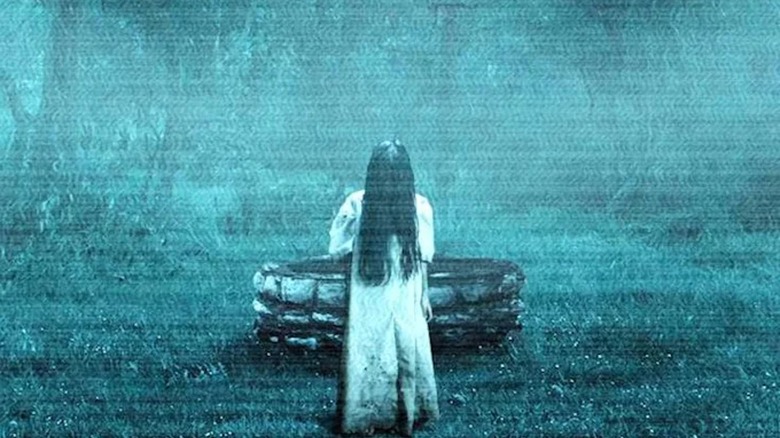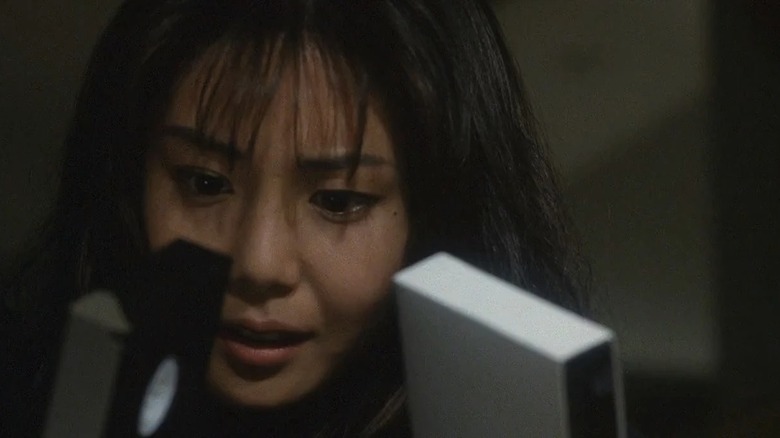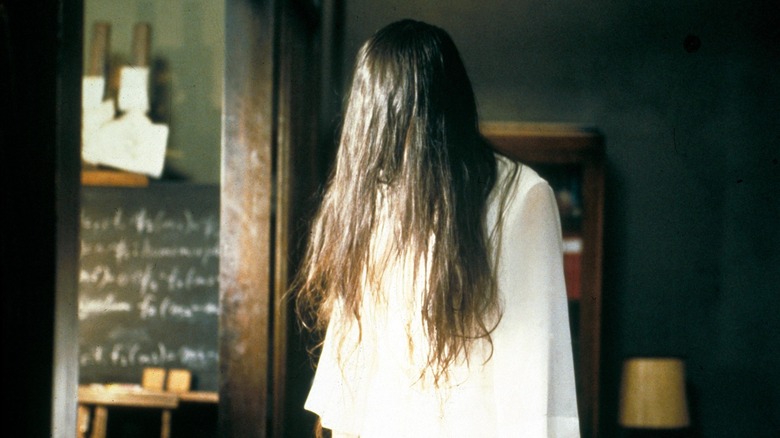The Real-Life Woman That Inspired Japanese Horror Classic Ring
Hideo Nakata's 1998 J-horror sensation "Ring" ("Ringu") revolves around images, mainly the distortion of photographs that denote Sadako's (Rie Inō) marked victims, and the eerie, anxiety-inducing cursed tape that comes alive in grotesque ways. Even Gore Verbinski's 2002 remake employs this photographic distortion — smudged and blurred faces that hint at the tragedy that befell the ones photographed, as if their very souls were smudged out of the frame.
The idea that photographs capture the essence of our souls is not recent, nor is its relation to spirit photography far-fetched, as the shadows and aberrations captured are often considered proof of something amiss. When Nakata was asked about this concept in an interview with Offscreen, the director affirmed that the idea for the smudged photos was inspired by a real-life woman who could allegedly manipulate objects with her clairvoyance, just like Sadako's influence manipulated the photographs:
"Mister Takahashi, who wrote the script with me, suggested strongly that we have the idea of the photos, which is actually based on a real-life person named Mifune Chizuko, a paranormal. As a paranormal this woman, Mifune, was able to project written words on paper and make words materialize on paper, these are things that paranormals can usually do ... This kind of shinrei shashin, which is the appearance of ghosts and spirits in photos, apparently really happened in Japan ... All this is related to the photographs and the image distortion we use[d] in the film."
Nakata's mention of Mifune Chizuko is rather interesting, as her story also serves as the blueprint for Shizuko, Sadako's mother, who is characterized as a renowned psychic in Koji Suzuki's "Ring," the novel that Nakata's film is based on. Let's learn more about the real-life Chizuko, and how her clairvoyance proved to be a double-edged sword.
Chizuko, the inspiration behind Shizuko in the Japanese Ring
Let us start with a Tokyo Imperial University assistant professor named Fukurai Tomokichi, whom Nakata also mentions in the interview linked above in relation to Chizuko. Tomokichi was researching extra-sensory perception from a supernatural lens and was interested in a method known as a mesmeric state, a form of hypnosis that was believed to alter memory, perception, and consciousness in the duration of the fugue state. Mesmerism became a coveted experience during the early 1900s, as people believed it to be a conduit for attaining clairvoyance and other special abilities. Chizuko, a woman who was introduced to a variation of this hypnosis by her in-laws, allegedly developed abilities by the age of 24, piquing Tomokichi's interest as a possible research test subject.
After testing her alleged abilities privately, the professor held a public experiment on 15 September 1910, where Chizuko had to state what was written inside sealed envelopes, and mentally project the same writings to a target object near her. This experiment was overseen by physicist Yamakawa Kenjiro and was conducted over in the presence of several groups, and Chizuko's abilities appeared to be genuine at first glance. However, the press honed in on several flaws in the experiment: it was not controlled appropriately, as the writings in the envelopes were furnished by Tomokichi instead of a third party and the seals were tampered with. Moreover, Chizuko was left alone with the envelopes in a separate room for some time, further diluting the rational integrity of the experiment and its outcome. A combination of these factors sullied Chizuko's reputation, and she was publicly reviled for being a charlatan.
In a severely tragic turn of events, Chizuko died by suicide four months later from ingesting poison.
The birth of a doomed, tragic character in Nakata's Ring
Koji Suzuki's "Ring" novel directly mirrors Chizuko's tragic story in Shizuko's arc, whose death is one of the core reasons behind Sadako's unmitigated rage. In Nakata's film, we learn about the events that befell the island of Ōshima, where a psychic named Shizuko Yamamura gained great renown after predicting a volcanic eruption. However, this fame turns against her when a professor of parapsychology exploits Shizuko's abilities, leading to a public demonstration gone wrong. After the local reporters question her abilities, and these criticisms lead to her suicide, Sadako unleashes her powers on the press, killing several. This rage fuels her even after death, and the cursed tape becomes a portal to hell, spreading like a disease that cannot be treated unless Sadako's spirit is assuaged.
Although Shizuko is not the focus of "Ring," her tragic death serves as the catalyst for everything in happens after, especially in Suzuki's novels, which detail Sadako's deteriorating psyche after the incident in vivid, excruciating detail. The virality of Shizuko's fame, which became a double-edged sword later on, is translated into the virality of the cursed tape, which takes on the form of a contagion that is replicated again and again to ensure survival. Just as the former claimed an innocent life, the latter went on to claim the lives of many unwitting souls, like a chain reaction that has a lot to say about the spectral nature of the moving image.


